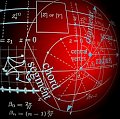TASK 1 The data listed in the table is a set of population figures (in this case, the US population) in
TASK 1
The data listed in the table is a set of population figures (in this case, the US population) in millions of people for every ten years beginning in 1790.
Your task is to use the population data to find an acceptable mathematical model for the growth of the US population.
Let
P(t)
be the function that gives the US population at time
t
.
The spreadsheet represents a set of population figures (in this case, the US population) in millions of people for every ten years beginning in 1790.
Column 1: the time
t
in years after 1790
using intervals of 10 years, i.e., 1790 corresponds to
t
= 0, 1800 corresponds to
t
= 10, etc.
Column 2: the US population at time
t
.
Column 3: the growth rate
P'(t)
, calculated by using the symmetric difference quotient
Column 4: the relative growth rates
Part 1
:
Assume the relative growth rate is a linear function of time, i.e. \(\frac{1}{P}\frac{dP}{dt}\) \(=b+at\).
Do a scatter plot of relative growth rate versus time. Next, fit a linear regression to the plotted points. You must supply: 1) a printout of the graph of the regression superimposed on the scatter plot (include a viewing window) and 2) the equation for the regression with
a
and
b
accurate to four significant digits.
Part 2
:
In Part 1: you found
a
and
b
such that \(\frac{1}{P}\frac{dP}{dt}\) \(=b+at\).
Use
P
0
=3.9 as your initial condition to find the particular solution for this differential equation. Note: You may find it easier to solve in terms of the constants
a
and
b
. Show all the steps in your solution.
TASK 2
This task requires you to test your results from the previous task.
Part I:
In completing Section A of the previous task, you were asked to do a linear regression of relative growth rate versus time. Calculate the correlation coefficient
r
to four significant digits for your linear regression.
Part II:
What is the long term prediction of your model? Answer this question by calculating
lim
P(t)
t
for the function
P
that you obtained in Section B of the previous task. Justify your answer.
TASK 3
Part I: Use the equation for P(t) that you obtained in Task 1 to predict the US population in a) 2010, b) 2015 and c) 2020.
Part II:
Your next task is to validate the results that you found in Part I. If your model is a good one, it should be able to accurately predict the population for the year 2000. Repeat the steps that you took to find
P(t)
while completing Task 1
except do not use the data for the year 2000.
Use your new
P(t)
to predict the population for the year 2000. In 250 words or less, use the results from your new
P(t)
to defend or reject the values that you calculated in Part I.
(Your solution should include the new values for the linear regression, P(2000) for your new P(t), and the essay).
TASK 4
Your task in this objective is to formulate a new mathematical model for US population growth.
Part I
Assume the relative growth rate is a linear function of population at time \(t\), i.e.
\[\frac{1}{P}\frac{dP}{dt}\] \[=b+aP\]- Do a scatter plot of relative growth rate versus population.
b) Next, fit a linear regression to the plotted points.
You must supply 1) a printout of the graph of the regression superimposed on the scatter plot (include a viewing window) and 2) the equation for the regression with a and b accurate to four significant digits.
In part I, your found a and b such that \(\frac{1}{P}\frac{dP}{dt}\) \(=b+aP\).
Use P 0 =3.9 as your initial condition to find the particular solution for this differential equation. Note: You may find it easier to solve in terms of the constants a and b . Show all steps in your solution.
Deliverable: Word Document




![[Solution] Part B: Proposed Research The researcher is working on [Solution] Part B: Proposed Research The researcher](/images/solutions/MC-solution-library-80746.jpg)
![[Steps Shown] Case Problem 1 Workload Balancing Digital Imaging [Steps Shown] Case Problem 1 Workload Balancing](/images/solutions/MC-solution-library-80747.jpg)
![[See Steps] Case Problem 1 PLANNING AN ADVERTISING CAMPAIGN The Flamingo [See Steps] Case Problem 1 PLANNING AN](/images/solutions/MC-solution-library-80748.jpg)
